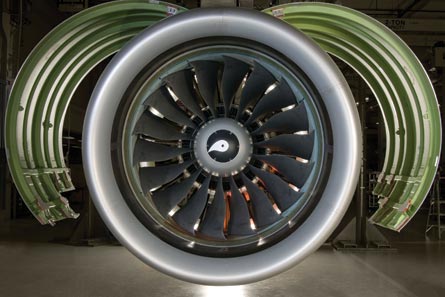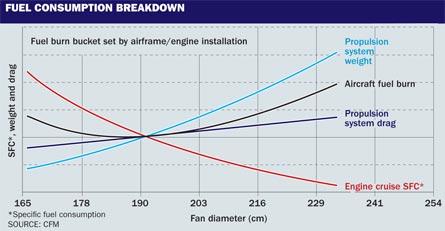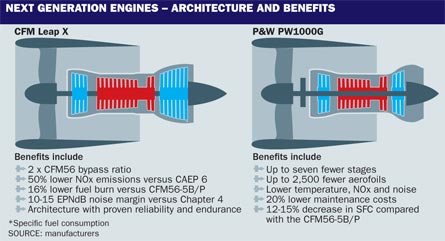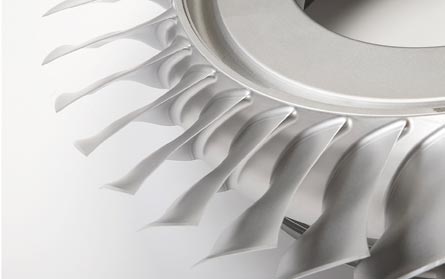Rivalry is alive and well when it comes to the "best" architecture for a new jet engine that will deliver the mandates of the next-generation narrowbody - double-digit reductions in fuel consumption, 50% below CAEP 6 nitrogen oxides emissions levels and 10-15dB quieter than Chapter 4 noise standards, not to mention high reliability and long on-wing time.
If you are rooting for the team based in Ohio, the clear choice is a traditional centreline architecture punctuated by a trove of advanced technologies. Over in Connecticut, the obvious solution is a geared engine that allows fewer parts and a slower-spinning fan.

Rather than problematic, the diversity of opinion and design by CFM International with the Leap X advanced turbofan, and Pratt & Whitney with its PurePower PW1000G geared turbofan, are by and large a positive for competition. Each team's engine, at least on paper and in preliminary tests, will meet the performance goals, despite what the other might tell you. And divergence in paths, if nothing else, has led to spirited debates that keep the industry buzzing with anticipation about new wins and will continue to do so at Farnborough.
Airframers to date have found merit in both designs for their twinjets: Bombardier chose the PW1000G series to power its CSeries airliner, set for service entry in late 2013, as did Mitsubishi for its MRJ regional jet and Irkut for the MS-21 mainline jet family. Comac, with marketing plans for thousands of 150- to 170-seat C919 twinjets, picked the CFM solution for a 2016 service entry.
Re-engined and next-generation single-aisles being contemplated by Airbus and Boeing are the looming big ticket items on both P&W and CFM's horizons. Manufacturers are leveraging their designs for other markets as well, with CFM partner GE developing a TechX version of the Leap X core for the business jet market, and Pratt & Whitney Canada using the PurePower core for its PW800 business jet engine.

A tour through the engines, in the latest configuration revealed, helps to see where the manufacturers concur, where they respectfully disagree, and why.
The physics of the desired engine performance are not open to dispute: the greater the propulsive efficiency and thermal efficiency of the engine, the lower the specific fuel consumption. Less fuel burned equals lower operating costs and reduces carbon dioxide emissions. How manufacturers boost one or both efficiencies determines the architecture of the new engine and is open to much debate.
Propulsive efficiency, the ratio of energy converted to thrust, increases with fan diameter and bypass ratio (the ratio of bypass flow to core flow), which typically means designing a larger fan and smaller core that accelerates a larger amount of air more slowly (low fan pressure ratio). While turboprop or open rotor designs can achieve the highest possible propulsive efficiency, roughly 92%, a turbofan (ducted fan) engine is typically limited to 70-80%, the efficiency increasing with fan diameter and bypass ratio.
From a design perspective, a larger fan means a heavier engine to hold the larger fan and more drag from the increased frontal area, plus aircraft integration impacts. Engine makers and airframers during the design phase of a project perform an engineering trade-off study, looking for the sweet spot where an engine's specific fuel consumption generates the best combination of engine weight, drag and aircraft fuel burn.
|
|---|
For a narrowbody such as the Comac 919, the trade revealed that a fan diameter of about 190.5cm (75in) was best. For CFM, that led to a bypass ratio of roughly 10:1 for the Leap X1C, almost twice the bypass ratio of today's CFM56 engines.
Thermal efficiency, how well the engine converts the energy from combustion into kinetic energy in the turbines, is typically limited to about 50%, but can be increased by boosting the pressure, hence the temperature, of the air entering the combustor, providing the same energy for less fuel burned. The upside of is better fuel economy; the downside is the potential for reduced life of the parts downstream of the combustor and more nitrogen oxides emissions, which can increase as the combustion temperature increases.
P&W has rooted itself firmly in one camp for its next engines. The PurePower 1000G family, which been described as the sexier option of the two engines given its decidedly different architecture and slashed part count, relies largely on an increase to propulsive efficiency for its roughly 12-15% decrease in SFC compared with the CFM56-5B.
CFM on the other hand is designing a relatively traditional centreline engine with roughly equal improvements in thermal and propulsive efficiency for its 14-15% SFC reduction compared with the latest CFM56 models, which means a larger fan as well as higher pressures and hotter air temperatures in the core. Like P&W, CFM is partially offsetting the heavier weight penalty of a larger bypass by using lighter weight advanced materials for fan blades and other elements of the engine.
The PurePower 1000G family features an eight-stage high-pressure compressor (HPC), developed jointly with MTU Aero Engines, low emission "Talon X" combustors and a two-stage high-pressure turbine (HPT) in its core. Downstream of the HPT is a three-stage low-pressure turbine (LPT), also built by MTU, that drives a three-stage low-pressure compressor (LPC) for the CSeries (and a two stage LPC for the MRJ) and, ahead of the LPC, five-star gears that ride on a 1mm (0.04in) oil film in journal bearings connected to the fan through a 3:1 gear ratio. Similar to the CFM engine, the overall pressure ratio of the 1000G is about 40:1, about half of which comes from the core.

The gear configuration allows the LPC and LPT to spin at higher, more optimal speeds while keeping the fan turning at a slower speed that reduces the fan pressure ratio (allows more air to flow through the bypass) and keeps the tip velocities below Mach 1.0 for decreased drag and noise.
The slower speed also means significantly less energy must be absorbed in handling birdstrike collisions, a design bonus that will allow P&W to experiment with weight-saving fan blade materials, containment shroud and pylon attach designs. Most two-spool engines have fan tip speeds of about Mach 1.35, says P&W senior vice-president of engineering Paul Adams. CFM notes that its Leap X engine will run "at just over M1 fan speed", however.
By allowing the LPT to spin faster, P&W was able to cut around three LPT stages and roughly 1,500 turbine blades from the design, nearly half of the 3,500 aerofoils in a typical turbofan engine, a feature that in part allows the company to advertise a 20% reduction in maintenance costs.
What that means for P&W is an engine that has fewer parts and runs cooler, but is more complex with respect to other turbofan engines because of the gearing system and associated oil cooling hardware.
Both companies have a history in studying geared concepts. Alan Epstein, P&W's vice-president of technology and environment, says the company in an effort with NASA tested a variable pitch 40,000lb thrust (178kN) non-flight geared turbofan with a bypass ratio of 15 on the ground and in the windtunnel in 1991.
In 2001, P&W built an 11,000lb-thrust version with a flight weight gearing system that it tested at Pratt & Whitney Canada. Then in 2007 and 2008, P&W tested the fan and gear system on a PW6000 engine strapped to its company 747 testbed followed by tests by Airbus on an A340. P&W plans to start full engine tests for the 24,000lb-thrust PW1524G engine for the Bombardier CSeries in the third or fourth quarter this year.
Both P&W and General Electric, a 50/50 partner with Snecma in CFM, tested open rotor designs in the 1980s, when a surge in fuel prices spawned the industry to research methods to cut fuel burn. While both proved the concept feasible, technical issues with noise and with blade pitch mechanisms would need additional research. After fuel prices eased, research was discontinued until fairly recently.
Epstein says the work proved that "you could fly a propeller at M0.8", but that it was "astonishingly noisy" on the ground when cruising at 30,000ft (9,150m), largely because the engines were not noise optimised.
GE too did its research with GTF concepts, first in the mid-1970s with NASA as part of the Quiet, Clean, Short-haul Experimental Engine programme. The engine featured a 12:1 bypass ratio, 2.5:1 reduction gearbox and variable pitch 18-blade composite fan. As recently as five years ago, CFM also revisited a geared turbofan along with other contender technologies, including a counter-rotating ducted fan and inter-cooled design, when it began the Leap X development programme.
In the end, CFM chose a more conservative approach. "The top driver for CFM is reliability," says Leap programme director Ron Klapproth. "If I can get the same performance without bringing in all that complexity, why wouldn't I do that?" Klapproth says a geared turbofan might make sense for a 20:1-class "very high bypass" niche, but that is a niche towards which CFM and GE are leaning, using an advanced technology contra-rotating open rotor design aimed for 2025 and beyond and with a 25% reduction in SFC.
For the mid-term, CFM is designing its 30,000lb thrust-class Leap X engine with a lighter three-dimensional woven resin transfer mould (RTM) composite fan rather than the traditional solid titanium blades on the CFM56. When coupled with a lighter containment casing and lighter attach structure, the new fan blades will save 454kg (1,000lb) per aircraft, says Klapproth.
P&W worked with its fellow United Technologies company Hamilton Sundstrand to develop an 18-blade RTM fan for the PurePower engine, but has decided to use a hybrid metallic design instead, saying the hybrid is more efficient due to its thinner leading edges and has better foreign object debris resistance. Epstein says the company has selected the fan material, but is now working out details of who will produce the blades.
As for all CFM56 engines, GE will build the Leap X core in the USA and Snecma will build the 18-blade fan and low-pressure sections in France. The low-pressure elements is likely to include a four-stage LPC and six-stage LPT, though CFM has not yet published the details. GE at present is planning for a 10-stage HPC, up one stage from the CFM56, followed by second generation lean-burn combustors, the first generation being that which is certificated on the GEnx engines for the Boeing 787 and 747-8 programmes.
Due to the higher core pressure and thermal efficiency, GE has developed new shapes and air cooling pathways for the nickel-based, single-crystal super alloy HPT blades. As for the CFM56, the blades are coated with Yttria-stabilised zirconate (YSZ) thermal barrier coatings, and operate at around the same temperature as the heritage engines, says Klapproth. First runs of a fully built-up engine are planned for 2013, followed by Leap X1C certification in 2014.
The product patriotism is likely to grow more intense for the generation-two Leap and PurePower engines set to deliver another round of 10% or more SFC reduction for new aircraft by 2025. P&W says it will begin testing its 16-18:1 bypass geared, ducted fan answer in 2014-15. CFM says it is making progress in windtunnel testing on a new round of lower noise blades for an open rotor solution, the company's favoured path for the long term.
CFM VERSUS PRATT & WHITNEY
Point/counterpoint On the reduced part count in Pratt & Whitney geared turbofan low-pressure sections
CFM Says that in a shop visit for the CFM56, 93% of the cost comes from the core and forward section of the low-pressure turbine. It says P&W has fewer parts in the booster (low-pressure compressor) and back stage of the LPT, but those areas are less than 7% of the maintenance costs.
P&W Maintains that replacing nickel super alloy (blade material in the LPT) with steel for the gear system makes for an inherently lower-cost engine to make and maintain, with fewer exotic materials.
Point/counterpoint On hot section temperature
P&W The company believes its rival's Leap X has a 100-150e_SDgrF (37.7-65.5°) hotter turbine inlet temperature and 10-15.5e_SDgrC hotter compressor exit temperature, which it says will probably have a substantial impact on [part] life.
CFM Says maintenance costs are related to the metal temperature, not the air temperature. CFM says it has designed the Leap X HPT blades to operate at the same temperature as CFM56 blades.
Point/counterpoint On having a gearbox with respect to maintenance
CFM Warns that there is a 5-10% increase in maintenance costs in its GE turboprop business because of the gearbox.
P&W Is telling customers they will not have to do anything to the gearbox for 40,000h, which is two overhaul cycles. Says it has not been successful in getting the gears to wear in testing to date.
Source: Flight International
























